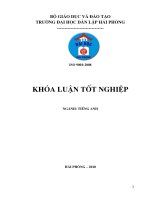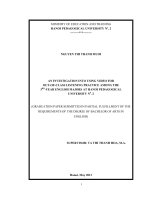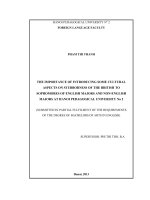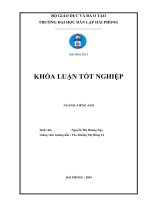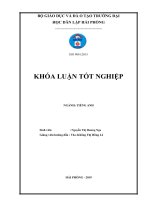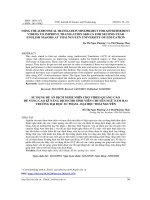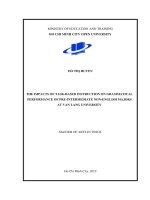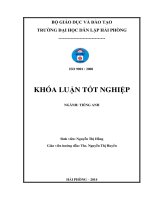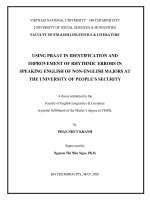Chuyên đề tốt nghiệp: The Impact of using Google Translate on the Process of English-Vietnamese Translation of Business English majors at National Economics University
Bạn đang xem bản rút gọn của tài liệu. Xem và tải ngay bản đầy đủ của tài liệu tại đây (8.91 MB, 48 trang )
<span class="text_page_counter">Trang 1</span><div class="page_container" data-page="1">
NATIONAL ECONOMICS UNIVERSITYFACULTY OF FOREIGN LANGUAGESDEPARTMENT OF BUSINESS ENGLISH
---000---TRAN THI DUNG
THE IMPACT OF USING GOOGLE TRANSLATE ON THE PROCESS
OF ENGLISH-VIETNAMESE TRANSLATION, BUSINESS ENGLISH
MAJORS, NATIONAL ECONOMICS UNIVERSITY
</div><span class="text_page_counter">Trang 2</span><div class="page_container" data-page="2">NATIONAL ECONOMICS UNIVERSITY
FACULTY OF FOREIGN LANGUAGESDEPARTMENT OF BUSINESS ENGLISH
---000---TRAN THI DUNG
THE IMPACT OF USING GOOGLE TRANSLATE ON THE PROCESSOF ENGLISH-VIETNAMESE TRANSLATION, BUSINESS ENGLISH
MAJORS, NATIONAL ECONOMICS UNIVERSITY
Supervisor: LE THUY LINH, MA
</div><span class="text_page_counter">Trang 3</span><div class="page_container" data-page="3">Tran Thị Dung — 11191180 - Business English 61C
I also learned a lot from all of the lectures in the Faculty of Foreign Language overthe course of my four years of study at National Economics University and gainedhelpful practical experience. My future path is aided by their dedication to andpassion for each lesson.
In addition, I would like to thank 100 students majoring in Business English from3 classes of Faculty of Foreign Languages at NEU, intake 61 whose participationis significant in this research paper.
I would like to express my gratitude to everyone for their offers of direct and
indirect help in completing my research.
</div><span class="text_page_counter">Trang 4</span><div class="page_container" data-page="4">Tran Thị Dung — 11191180 - Business English 61C
EXECUTIVE SUMMARY
Technological development brought various tools to help learners overcometheir difficulties and GT is the ideal option among students. Realizing the trendsfor the future, the researcher conducted a research to evaluate the impact of GT on
the English-Vietnamese translation process of final-year Business English
students at NEU. The research also sought to determine the impact of using GT,and the advantages and disadvantages of this tool as well. The researcher thenaimed to provide a few solutions to these limitations.
To be more specific, a set of ten questions in total was brainstormed and dispatchedamong 100 students of Business English Department, intake 61 at NEU. Then, theresearcher gets the data to analyze. Based on the analysis and findings, studentsare shown to have been using GT into their English-Vietnamese translation processto improve themselves as well as simplify all tasks.
<small>1</small>
</div><span class="text_page_counter">Trang 5</span><div class="page_container" data-page="5">Tran Thị Dung — 11191180 - Business English 61C
LIST OF ABBREVIATIONS
Business English
Example-based machine translation
Google Neural Machine Translation system
Google Translate
Source Language
Target Language
<small>iii</small>
</div><span class="text_page_counter">Trang 6</span><div class="page_container" data-page="6">Tran Thị Dung — 11191180 - Business English 61C
LIST OF TABLES AND FIGURES
Table 3.1. Evaluation Criteria for Likert Scale Questlons...--- --«‹- 20Table 3.2. Business English students’ Perceptions about the Use of GoogleTranslate oc. ... 21Table 3.3 .The translation results when using Google Translate... -- 22
Table 3.4. The efficiencies of using Google Translate for Translation ... 23
Figure 3.1. Students’ frequency of using GT on the Translation process... 17
Figure 3.2. The deficiency students most encountered when using Google
Translate... ... 25
Figure 3.3. Students’ satisfaction about Google TransÏafe... --«-+ 27
<small>1V</small>
</div><span class="text_page_counter">Trang 7</span><div class="page_container" data-page="7">Tran Thị Dung — 11191180 - Business English 61C
TABLE OF CONTENT
ACKNOWLEDGEMENT...- LH HH ng 1EXECUTIVE SUMMARYY... LH HH ng HH HH iiTABLE OF CONTTENTT... .- LH HH ng ng HH nghệ iiiLIST OF ABBREVIA TIƠNS... HH HH HH TH HH HH iiiLIST OF TABLES AND FIGURES...-- - ng dê ivCHAPTER 1: INTRODUCTION...- .- Ăn S2 +2 9g re 1
1.1 Rationales... SH ng HH HH 11.2. Research quesfÏOnS...- - Ác 1v. 1T HH HH ky 2
1.3. Scope of the researCh...- -.- SH TH TH HH ng 2
1.4. Research methodoÌ0gð...-- --- 6s + ng HH Hư 31.5. Organization of the researTh...- --- Á HS HH nhe 3CHAPTER 2: LITERATURE REVIEW... HH re 52.1. Overview of TransÏafÏ0n...- s1 HH ng ng 52.1.1. The Definition Of TTAHSÌAfÏORN... cv ekerkeeeeeeree 5
2.1.2. The importance Of TTAH(SÏ(ÍÏOPH... 5k 6
2.1.3. Translation PFOCASS... ng ng nh ngư 8
2.2. Overview about Google 'TransÌafe...- -- s5 key 10
2.2.1. Google Translate feature ANd FUNCTION. ...ààec c5 S5 Ss s2 102.2.2. Pros and cons Of Google Translate ...ccccccccccccccssecescessecesecesseeeseeesaeeeses 122.3. How Does Google Translate Worrk2...- ch HH re, 15CHAPTER 3: ANALYSIS AND FINDINGS... co eeằ 17
3.1 Students’ frequency of using GT on the Translation process. ... 17
3.2. Business English students’ Perceptions about the Use of GoogleTranslate oo... ... 203.3. The translation results when using Google Translafe... 223.4. The efficiencies of using Google Translate for Translation... 23
3.5. The deficiency students most encountered when using Google
'TransÌÏafe... .- - - c2 2 0111 HH ng nếp 25
</div><span class="text_page_counter">Trang 8</span><div class="page_container" data-page="8">Tran Thị Dung — 11191180 - Business English 61C
CHAPTER 4: RECOMMENDA TIONS... Hee 28
CHAPTER 5: CONCLUSION... LH HH HH HH HH rưy 31
5Š.l. SUININAFY... Gà Hưg 315.2. LimÏfafÏOIS...- Ghi rư 325.3. Suggest for further researcch... - - Gv HnHnHngnH g ry 32REFERENCES... LH ng HT HH HH HH HH 33APPENDIX
<small>VI</small>
</div><span class="text_page_counter">Trang 9</span><div class="page_container" data-page="9">Tran Thị Dung — 11191180 - Business English 61C
CHAPTER 1: INTRODUCTION
1.1 Rationales
In terms of human civilization, translation activity is not really new. It may be
argued that translation has existed from the dawn of human civilization, at alllevels, to take a term from Jacobson, such as intralingual, interlingual, andintersemiotic. The oldest, estimated to be between 6000 and 10,000 years old, hasreportedly been discovered in the Middle East, more precisely in the town of ElbaKuna. Translation plays a significant part in human communication as a
fundamental way of information exchange across many nations and cultures. A
compelling need to include translation practice in university curricula and providestudent translators with real-world experience that meets employer expectationsafter graduation has developed in view of the expanding global demand fortranslation. In the contemporary day, technology is also used in translation. It isundeniable that the technology has dramatically changed the translation industryglobally. With today's Internet technology, anyone may access information fromanywhere in the world at any time. Effective information retrieval from a web pageis challenging, though. Google is one resource that facilitates efficient informationsearching for internet users. Google Translate is one of the many applications thecompany currently provides. The content shown on a web page on the Internet canappear in a range of languages, Google's developers understood. If a person doesnot speak the source language, language might be a barrier to understandinginformation. Google's machine translation is a solution in that case. More than 100different languages are currently supported by Google Translate.
Even though Google Translate has significantly evolved, there hasn't been muchin-depth research on its use in student education in all of the Translation process,and the students gets the difficult problem in their translation process. Hence, theresearcher decides to carry out this investigation about “The Impact of usingGoogle Translate on the Process of English-Vietnamese Translation of Business
English majors at National Economics University”
</div><span class="text_page_counter">Trang 10</span><div class="page_container" data-page="10">Tran Thị Dung — 11191180 - Business English 61C
1.2. Research questions
The research aims at how GT impacts on students' the process of English Vietnamese translation, the frequency, the reasons for using app and someefficiencies and deficiencies arise when using this tool. Also, the researcher willprovide solutions, recommendations to the problems to encourage students to useapp as a tool to simplify translation work, and save time for translating. Theresearch is conducted to answer the following research questions:
-e What can Googl-e Translat-e h-elp stud-ents during th-e translation proc-ess?
<small>e@ What are the effectiveness and deficiency of the texts in Vietnamese created</small>
by Google Translate?
1.3. Scope of the research
This research is confined to Translation from English into Vietnamese of 100
Business English major students intake 61 at National Economics University,using Google Translate. The researcher decides to choose final-year studentsbecause this is the time they have completed at least two courses in a three-course
The scope of the research is limited to Business English students intake 61 atNational Economics University, so I only focus on translating from English toVietnamese. Moreover, translating into Vietnamese is a translation into the mothertongue. In the translation process, we also need to have knowledge in social,
cultural, linguistic, etc... People find it simpler to compare with their mother
tongue as a result.
Google Translate is a well-known machine translation tool. The Vietnamese language pair is one of several pairs of languages with increasingaccuracy. Many years ago, when a professional translator was not available,Google Translate has been used to assist individuals in translating words, phrases,clauses, or entire paragraphs from one language (SL) to another. The majority
English-throughout the world use Google Translate, making it the most well-liked machine
</div><span class="text_page_counter">Trang 11</span><div class="page_container" data-page="11">Tran Thị Dung — 11191180 - Business English 61C
translation. According to Kroulek (2016), 103 languages are currently supportedby Google Translate, which is used by more than 500 million people daily totranslate more than 100 billion words. Thus, it emphasizes the significance of
Google Translate's translation quality. Furthermore, Google Translate can be usedfor free, in contrast to other prominent translation software. No need for highexpenses, subscription fees, or anything else. All you have to do to use it is openthe app or your browser. Consequently, we should anticipate machine translationtechnology developing quickly.
1.4. Research methodology
This reasearch aims to find out the support of GT in the Translation process. Theresearch is conducted by combining both qualitative and quantitative methods,informing the questionnaire for students, respectively. The population of thisresearch was the students of Business English Department at NEU. The sample ofthis reasearch was the 7th semester students in Business English Department. Thequestionnaire in this research will be designed by the researcher. The questionnairecollects quantitative information on the participants as well as broad perceptionsabout a group (Fraenkel, Wallen, & Hyun, 2015). The first section was intended togather general information, the frequency of using GT, students’ perceptions, andany writing-related obstacles they may be facing. As a result, the second portionsought to clarify how they actually used GT. It had four statements, each of whichasked for a response from 1 to 5 on the Likert Scale (1= strongly disagree, 2=disagree, 3= neutral, 4= agree, 5= strongly agree). Through the use of the StatisticalPackage for the Social Sciences program (SPSS Statistics), all quantitative data
were analyzed using descriptive statistics (Mean).
1.5. Organization of the research
The research consists of four parts:
Chapter 1, Introduction. This part presents the rationale, the scope, the researchquestion, the methods, and the design of the research.
</div><span class="text_page_counter">Trang 12</span><div class="page_container" data-page="12">Tran Thị Dung — 11191180 - Business English 61C
Chapter 2, Literature review, provides readers an overview of the topic including
the basic theoretical background about Translation and Google Translate, andapplication of Google Translate on the Process of English- Vietnamese Translationof BE students.
Chapter 3, Analysis and Findings, provides data analysis, major findings ofstudent and give some recommendations for BE students to using GT effectivelyon the process of English - Vietnamese translation
Chapter 4, Recommendations for some solutions when using Google Translate onthe process of English — Vietnamese translation
Chapter 5, Conclusion summarizes the research, limitation of the research, and
giving some suggestions for further reasearch.
The references and appendix are also included to ensure the accuracy
</div><span class="text_page_counter">Trang 13</span><div class="page_container" data-page="13">Tran Thị Dung — 11191180 - Business English 61C
CHAPTER 2: LITERATURE REVIEW
2.1. Overview of Translation
2.1.1. The Definition of Translation
Translation is the act of converting communications from one language to another,although there are various meanings of the term, such as the one provided by theOxford Dictionary, which states that translation is the process of converting
anything that is said or written into a different language. Before doing the actual
translation, it is necessary to understand translation in order to acquire thecompetence of translating English sentences from a source language into a targetlanguage. However, it's not that easy to define what translation is. There are several
definitions of translation offered by different experts. They provide severalmeanings for the term "Translation."
According to Wiratno (2003), translation is the process of converting a messagefrom SL to TL. The source language is referred to as the "Source Language," whilethe "Target Language" is the language into which the translation is made. Hemakes the following statement in his book: “PenerJemahan ialah proses pengalihanpesan dari bahasa sumber ke dalam bahasasasaran. Bahasa sumber adalah bahasaasal yang diterjemahkan, sedangkan bahasasasaran adalah bahasa target yangdigunakan untuk mengungkapkan hasilterjemahan.”
In a book titled "Approaches to Translation,” the process of rendering the meaningof a text into another language in the way that the author intended the text is alsoreferred to as translation (Newmark, 1988, 2001)
Bell (1991) acknowledged translation as the expression in another language (targetlanguage) of what has been expressed in one language (source language),
preserving semantic and stylistic equivalencies in his book “Translation andTranslating: Theory and Practice”
The process of transferring a written text from SL to TL, described as translation
by Hatim & Munday (2004). The transfer of meaning or a message is not stated
</div><span class="text_page_counter">Trang 14</span><div class="page_container" data-page="14">Tran Thị Dung — 11191180 - Business English 61C
explicitly in this definition. They place a significant amount of emphasis on the
translation process.
Another definition of Translation from Nida and Taber (1982) is translatingconsists in reproducing in the receptor language the closest natural equivalent ofthe source language message. In comparison to the earlier definitions, this one ismore thorough. Translation problems are closely linked to issues with languages,
meaning, and equivalence, as said by Nida and Taber.
It can be concluded that there are many ways to define what translation is presentedby some experts and researchers above bear some similarities. Everyone usesdifferent lenses, so there is no "best" description. However, virtually all definitionsof translation in the profession contain the three essential components of sourcelanguage, target language, and meaning transfer. Simply said, translators translatea text from its source language into its target language. Furthermore, to ensure thatthe readers will understand the content, a translator must also consider the target text'scultural context. Therefore, when evaluating a translation, it is important to consider thetarget language and the source language's cultural context, as well as the message andaccuracy of the information intended to be transmitted in the source language, theaesthetic form the original author used.
2.1.2. The importance of Translation
It is virtually difficult to ignore how crucial translation is in this era ofglobalization, when almost everyone seeks to discover something new everymoment. We all know that translation is more than simply changing one languageinto another. It is also a challenging and essential technique to give us an idea sothat their real purpose may be understood without drawing attention away from
their original context. Additionally, translation brings two cultures from one part
of the world to the other.
According to Aji (2017), the translation function is very inherent with our dailylives. Unconsciously, it is familiar because it has been applied in our activities suchas: watching movies, reading novels, and newspapers, etc... Because so many
</div><span class="text_page_counter">Trang 15</span><div class="page_container" data-page="15">Tran Thị Dung — 11191180 - Business English 61C
literary works from other countries enter our nation, the need for translation of
written texts is growing. In the significance of developing literary works fromabroad, the role of translation becomes more significant. People also take it forgranted, knowing that without translation, most will be forced to keep to their ownculture. English is usually the most common language because it is the
international language.
Furthermore, in order to connect the world economy, translation is crucial. It isessential for companies to have international affiliations, clients, and consumers inthe era of globalization. Despite the widespread use of English, consumers stillprefer to read about products and services or interact with material in their nativetongue. In this context, translation is relevant. Because they must have a significantmarket share, translation is vital for small businesses. The availability of
translation is significant for businesses looking to attract customers from around
the world. There is a danger that if their competitors are successful in selling theirgoods in other languages, they would dominate the market, leaving the smallerbusinesses with no customers. A multilingual interface has been created by small
businesses with this idea in mind. As a consequence, customers won't have any
trouble navigating the website. The demand for translators is increasing as more
and more small businesses decide to advertise their material in numerous
languages. The need for translation working for these small businesses on multipleplatforms will thus undoubtedly increase.
International cultural exchange is facilitated through translation as well. In a worldwith over 7000 spoken languages, translation is crucial because it enablescommunication and understanding of concepts and cultures without the need foradditional language study. A professional translator should have some previousknowledge of the target language in order to successfully translate a specific textinto that language. Besides, translation is more than just translating a text intoanother language for the purpose of doing so. There should always be proper
meaning in a translated text.
But translation's significance in the modern world goes much beyond that.
</div><span class="text_page_counter">Trang 16</span><div class="page_container" data-page="16">Tran Thị Dung — 11191180 - Business English 61C
Translation is becoming an increasingly important part of daily life. It is much
more essential to have translation services now because we are continuallydeveloping and becoming a one, global community rather than a separated groupof individuals. You never know when someone may enter your office and speak adifferent language; if they are a new client or customer, you will have a problem.That is precisely why you need translation, since it greatly affects both the quality
of service you can offer and your level of availability.
2.1.3. Translation Process
Nida and Taber (1969) divided the translation process into three stages
1) message analysis in the SL, 2) transfer, and 3) reconstruction of the transferred
message in the TL. The following diagram explains how this procedure works.
<small>A (Source Language) B (Receptor Language)</small>
(Analysis) (Restructuring)
<small>xX (Transfer) ————*_ Y</small>
(Source: Nida and Taber (1969))
We can see from the figure that the source language is evaluating the link betweenwords and their meanings within sentences. The meaning was then translated fromSL to TL. Reconstruction is the stage of the translation process when the translatorrewrites or re-expresses the source text in order to make the final translation resultintelligible and acceptable in terms of TL norms and styles. In addition, according
to Nababan (2003:25), “Proses penerjemahan terdiriatas tiga tahap, yaitu 1)
analisis teks bahasa sumber (Bsu), 2) pengalihan pesan, 3)restrukturisasi.”. Three
</div><span class="text_page_counter">Trang 17</span><div class="page_container" data-page="17">Tran Thị Dung — 11191180 - Business English 61C
phases comprise the translation process: 1) analysis of the source language (SL),2) transmission of the message, and 3) reorganization.
However, translators are, to some level, necessary to learn and master the phasesin the translation process in order to express messages and ideas in the mostaccurate and natural ways. Different perspectives on the translation process areexpressed by many researchers. Nancy Matis (2015) structured the procedure intoseven major steps to be more precise. The first stage starts with communicationeither between the requestors or the translation service providers to explain therequest and prevent misunderstandings for those who plan to translate the papers.Following that, the translator will be able to analyze the news and current factsdepending on the description of their clients. The method’s third step involvesquotation. Translators evaluate and estimate the amount of time required to handleand satisfy deadlines before beginning the translation of the documents. Becauseall of the necessary supplies are available, projects may be started after preparation.The monitoring and closing phases of the process are used to review all errors andmake any necessary adjustments before. These stages of translation suggested by
Nancy put an emphasis on the organization and effectiveness of the entire process.
Catford (1965) stated that the linguistic approach to translation should come firstsince "translation having to do with language, the analysis and description oftranslation processes must make considerable use of categories set up for the
description of languages." The fundamental focus of the linguistic approach totranslation is on meaning and equivalence, in which the same meaning iscommunicated through a different type of expression. According to Douglas
Robinson, for some translators "reaching equivalence is the sole objective oftranslating. The target text must be as similar to the source text as possible (p.73).
According to the linguistic model, translation is seen as the replacement of eachSL component by its TL counterpart component. In terms of phonology,punctuation, and lexicology, it views translation as a fundamental transcoding of
textual units. This strategy takes use of Halliday's (1961) scale-and-categorygrammar, which views the structure of language as a collection of scales and
</div><span class="text_page_counter">Trang 18</span><div class="page_container" data-page="18">Tran Thị Dung — 11191180 - Business English 61C
categories operating at multiple levels (phonic, linguistic, lexical, realistic). Thetransposition of units frequently results in subpar TL writings since the context isignored. The substitution of lexical and grammatical units from SL into TL is notthe primary function of translation. Because the linguistic model does not take intoconsideration the totality of the text or the context of the text, it cannot be viewedas a representation of the translation process that aims to convert ST into TLappropriately.
In general, the translation process begins with a thorough analysis of the sourcetext and is followed by careful preparation of the source and target languages forthe translators. Reviewing the papers to make sure they are effective and natural isthe last step.
2.2. Overview about Google Translate
2.2.1. Google Translate feature and function.
Translation has never been simple for translators, experienced or inexperienced.Before beginning a translation assignment, translators invest a significant amount
of time researching related subjects, consulting dictionaries, or looking upterminology. Fortunately, a variety of translation tools have been created in the eraof the digital revolution to improve the accuracy and consistency of a translationand decrease the workload for translators. There are many translation toolsinvented to help people remove the language barrier such as Microsoft Translator,SDL Trados Studio, Yandex.Text, Memod...., but GT is the most popular for
translators, also students.
GT, is one of the most often employed online resources for translation, which iscompatible with computers, smartphones, and tablets systems with multiplefeatures (Gestantil, Nimasari, &Mufanti, 2019). Hampshire and Salvia (2010)argue that GT is the most frequent and favorite MT system among its users. Asbecoming a popular translation tool for FL learners, many
GT helps students learn foreign languages due to its distinctive characteristics
<small>10</small>
</div><span class="text_page_counter">Trang 19</span><div class="page_container" data-page="19">Tran Thị Dung — 11191180 - Business English 61C
of being free, easy to access with a quick translation process. (Kumar, 2012) GThas a rule-based translation machine that determines the translation of wordsusing a Statistical model in which it, immediately, translates the text to theEnglish language and, then, to the target language. (Kumar, 2012) The adequacyof the final result greatly depends on the amount of saved texts translated byhumans, and GT searches various documentations to achieve a suitable translationpattern in accord to earlier human-translated texts (Ghasemi & Hashemian, 2016)..To improve fluency and accuracy, GT shifts from sentence-based translationto Neural Machine translation, using Artificial Intelligence, in which it mimicshuman cognitive functions (Russel & Norvig, 2010). Instead of fragmenting theoriginal into chunks, GNMT takes the whole text and context into account to findthe most relevant translation and, then, rearranges and adjusts the text to make itresemble human-made with proper grammar and vocabulary (Wu et al., 2016)
In May 2014, GT was able to scan text or images and translate them instantly on asmartphone due to improvements in voice and visual quality. Furthermore, usersdo not need to tap the mic button for the system to translate speech and instantlydetect other languages.
In May 2014, GT was able to scan text or images and translate them instantly on a
device because to improvements in voice and visual quality. Additionally, thetechnology automatically understands foreign languages and translates voice
without having users to tap the mic button.
The "Neural Machine Translation" technology was integrated to Google Translate
in November 2016. In order to train a statistical model, NMT uses neural network
models, as explained by Brownlee (2017). To translate entire phrases at once andguarantee greater contextual correctness, it applies Deep Learning techniques.NMT translates entire phrases at once as linked to SMT's small-piece translation.With the end-to-end learning system installed on NMT, GT will undoubtedly getbetter over time as it figures out how to translate sentences better and more
naturally (Turovsky, 2016).
<small>11</small>
</div><span class="text_page_counter">Trang 20</span><div class="page_container" data-page="20">Tran Thị Dung — 11191180 - Business English 61C
In 2018, GT supports languages and translates more than 100 billion words a day.Not all of them use NMT, and not all of them support all of the functions. The
advantages of Google Translate over other machine translation tools are itsflexibility of use and accessibility through its various features.
Including text, photos, sounds, and videos, Google Translate can translate a varietyof documents. Specifically, GT can carry out Written Words Translation, WebsiteTranslation, Document Translation, Speech Translation, Mobile App Translation,Image Translation and Handwritten Translation. For most of its features, GT offerslistening translation, a dictionary, and accurate pronunciation. In order to achievequality translation, GT now offers functional help to translators.
2.2.2. Pros and cons of Google Translate
Currently, the most widely used machine translation tool in the world is Google
Translate. Google Translate, like any tools, has benefits and drawbacks of itsown.The positive aspects of using this particular technology are as follows:
The free and simple-to-use GT tool may benefit students and translators in a varietyof ways (Carl et al., 2014). GT also works quickly, which is one of its keyadvantages. In actuality, no human translator can match GT's speed or,
consequently, the volume of translations it can do. Depending on the text's
difficulty, an experienced translator can translate a maximum of 2,000 words(300-400 words/hour) in a typical workday. In comparison, GT can provide atranslation with the same number of words in just a few seconds. Furthermore,being a translation memory tool, GT becomes better as more translation orders andrevisions are processed. In addition, although technology can never be as effectiveas a human translator, GT can still be a useful tool for translators. The initialtranslation draft is frequently completed by GT by qualified translators. Aproficient human translator subsequently post-edits the machine-generateddocument. This can reduce translation expenses and save time. As a result, GT hasvarious advantages for users generally and language learners who are learningother languages specifically. Users can quickly and easily access GT service by
<small>12</small>
</div><span class="text_page_counter">Trang 21</span><div class="page_container" data-page="21">Tran Thị Dung — 11191180 - Business English 61C
using just electronic devices that have internet access. As a result, studentsmajoring in languages at all levels find it more convenient to learn foreignlanguages.
According to (Pujiati, 2017), Google Translate's benefits include Google Translatewas created as a service to help in translation. Quick vocabulary translation ispossible using Google Translate. Google Translate may be used to look up the
meaning of many terms that have not yet been included in dictionaries.
Additionally, it enables language translation for its consumers. Students canactually save more money using this program since they won't need to purchase adictionary to translate into a foreign language. Google Translate's primary purposeis translation, but it also gives users the option to learn pronunciation. Using this
advantage over using a dictionary is extremely advantageous to its users.
Because it is a free online translation tool accessible for use in the process oflearning English, particularly for translation, Google Translate is a wonderfulresource for studying in class or as a dictionary to support students. In 2016,Medvedev’s the statement "Google Translate is possibly one of the easiest andmost accessible tools to assist consumers fulfill their translation needs" is true.
Google Translate is a significant part of the "Google family." Students havelearned about the advantages of this program and use it more frequently since itprovides quick and imperfect double translation services in a variety of languages.
On the other hand, the negative aspect of using this particular technology is thatthe software often produces out-of-context, irrelevant, and absurd translations. Thequality of GT varies in translation language pairs. For example, English-Chinesetranslation will be more correct than that of English-Vietnamese translations or thequality of GT’s English—Arabic translations is invariably low and cannot be trustedunless a competent human being independently reviews them. From the reviews,
sometimes it makes inaccurate translations that can be misleading and drives meto do further research to understand the right meaning said by the user. Anothercomment is that it can sometimes feel quite right to translate something into atechnical terminology. Additionally, the translation may be rather nonsensical if
<small>13</small>
</div><span class="text_page_counter">Trang 22</span><div class="page_container" data-page="22">Tran Thị Dung — 11191180 - Business English 61C
the sentence contains context. GT, in contrast to a translator, frequently fails tounderstand the context of a language. Does GT recognize that you aren't referringto fruit when you mention the name Apple? Possibly not. Additionally, GT hastrouble interpreting specific cultural characteristics like customs, gestures, andother things. Non-text components, such as photos and emoji, which can havesignificantly different meanings in various contexts, cannot be translated by GT.
This is an example using GT to translate the following phrase into French:
“In their house, every family member has personal things. There is his big car and
her small car, his slippers and her slippers, and his books and hers.”
Here's what GT came up with: “Dans leur maison, chaque membre de la famillea des objets personnels. Il y a sa grosse voiture et sa petite voiture, ses pantoufles
et ses pantoufles, ses livres et les siens ”.
If we reuse the French-English translator, we get this sentence: “Jn their home,
each member of the family has personal goods. There is his big car and his littlecar, his slippers and his slippers, his books and his own”.
The problem is that in French and other Latin-based languages, nouns have gender,
and pronouns like "him/he" and "her/she" indicate the gender of the thing, not the
subject. GT did not understand the meaning to translate the sentence accordingly.For any person, that sentence is about a family where each member has personalbelongings. For example, GT used the word "sa" for both cars and "ses" for bothsandals. So we can't say anything about the car size of each family member. As aresult, the translation performed by GT did not convey the original meaning.
It is clear that the software has omitted the most important information in thesentence. People understand such sophistication but GT only handles lines ofwords and letters. It quickly processes pieces of text without understanding whatthey mean. Therefore, a translation system based on advanced AI technology canbe inaccurate and even flawed.
The working principle of GT application is based on pre-programmed typical word
<small>14</small>
</div><span class="text_page_counter">Trang 23</span><div class="page_container" data-page="23">Tran Thị Dung — 11191180 - Business English 61C
samples, then automatically translates each word into a language that needs to betranslated. Therefore, the coherence of meaning in a sentence, in a paragraph or ina long text is not guaranteed. For example, when learners want to translatedifficult-to-pronounce phrases (Tongue Twister) or idioms via GT, they will havedifficulty understanding the content of the text when translated into Vietnamese.
<small>coud 2 @</small>
2.3. How Does Google Translate Work?
A Statistical machine translation engine was launched with GT in April 2006. GTdoes not provide direct language translations. Instead, it initially translates toEnglish before transferring on to the target language (Blanchon, Boitet, Seligman
& Bellynck, 2010).
When translating a document, GT searches for patterns in hundreds of millions ofdocuments to help to choose the appropriate translation. GT makes educatedassumptions about what an appropriate translation should be based on patternsseen in papers that have already been translated by human translators.
The Google Neural Machine Translation system, developed by a research team atGoogle under the direction of software engineer Harold Gilchrist, was announcedin September 2016 in order to improve the fluency and accuracy of GT. InNovember, it was reported that GT would switch to the GNMT.
A sizable artificial neural network with deep learning capabilities is used in GT'sNMT system. GNMT uses an example-based machine translation technique, whichraises the quality of the translation "finds out by studying numerous examples. In other
<small>15</small>
</div><span class="text_page_counter">Trang 24</span><div class="page_container" data-page="24">Tran Thị Dung — 11191180 - Business English 61C
words, "It uses this broader context to help it determine the most relevant translation,which is then rearranged and adjusted to sound more like a human speaking with propergrammar (Turovsky, 2016). The GNMT network is able to generate interlingualmachine translation that gives "semantics of the sentence rather than simplymemorizing phrase-to-phrase translations", and the technology does not rely on humantranslators, although it exploits "the commonality found in many languages," It does
not develop its own global language (McDonald, 2017)
<small>16</small>
</div>